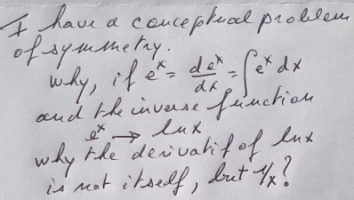I suppose what you mean by "symmetry by the bissectrice" is that the inverse function is the reflection of the original function in the line y=x that bisects the angle between the axes. Have you tried experimenting with this to see what implication it has?
What we can do to relate the
derivatives of a function and its inverse is this:
In the case [imath]f(x) = e^x[/imath], this means that the derivative of [imath]f^{-1}(x) = \ln(x)[/imath] is [imath]\frac{1}{e^{\ln(x)}} = \frac{1}{x}[/imath]. That is not [imath]\ln(x)[/imath].
Take the link to see more. The main difficulty in the way of the sort of symmetry you are looking for may be that the inverse function has a different argument than the original function.

![\left[f^{{-1}}\right]'(a)={\frac {1}{f'\left(f^{{-1}}(a)\right)}} \left[f^{{-1}}\right]'(a)={\frac {1}{f'\left(f^{{-1}}(a)\right)}}](https://wikimedia.org/api/rest_v1/media/math/render/svg/662f1be67eb38c8d7ecf30fd8afda594671fbeec)
![\left[f^{{-1}}\right]'(a)={\frac {1}{f'\left(f^{{-1}}(a)\right)}}'(a)={\frac {1}{f'\left(f^{{-1}}(a)\right)}} \left[f^{{-1}}\right]'(a)={\frac {1}{f'\left(f^{{-1}}(a)\right)}}'(a)={\frac {1}{f'\left(f^{{-1}}(a)\right)}}](https://wikimedia.org/api/rest_v1/media/math/render/svg/662f1be67eb38c8d7ecf30fd8afda594671fbeec)
